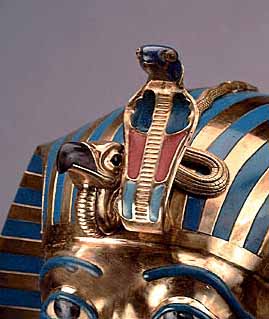

Kundalini is a Sanskrit word meaning either "coiled up" or "coiling like a snake." There are a number of other translations of the term usually emphasizing a more serpent nature to the word - e.g. 'serpent power'.
The caduceus symbol of coiling snakes is thought to be an ancient symbolic representation of Kundalini physiology.
The concept of Kundalini comes from yogic philosophy of ancient India and refers to the mothering intelligence behind yogic awakening and spiritual maturation. It might be regarded by yogis as a sort of deity, hence the occasional capitalization of the term.
Within a western frame of understanding it is often associated with the practice of contemplative or religious practices that might induce an altered state of consciousness, either brought about spontaneously, through a type of yoga, through psychedelic drugs, or through a near-death experience.
According to the yogic tradition Kundalini is curled up in the back part of the root chakra in three and one-half turns around the sacrum. Yogic phenomenology states that kundalini awakening is associated with the appearance of bio-energetic phenomena that are said to be experienced somatically by the yogi.
This appearance is also referred to as "pranic awakening". Prana is interpreted as the vital, life-sustaining force in the body. Uplifted, or intensified life-energy is called pranotthana and is supposed to originate from an apparent reservoir of subtle bio-energy at the base of the spine. This energy is also interpreted as a vibrational phenomena that initiates a period, or a process of vibrational spiritual development.
The source text for the concept of kundalini is the "Hatha Yoga Pradipika" written by Swami Svatmarama (English translation, 1992) somewhere between the twelfth and fifteenth centuries. Any examination of the topic should include this work. The pradipika is one of the later developments in yoga sacred texts. Hatha Yoga is strictly speaking a forcing technique which has as its primary aim the forcing of the arising of kundalini.
The main emphasis is a difficult regime of breathing techniques meant to increase the store of "prana" in the body. The well known physical postures are only meant to be an aid to maintain peak physical fitness, so as to support the real work of the breathing practices. All of this has, according to tradition, to be accompanied by prolonged and unbroken meditation practice (for which the main text is the "Yoga Sutras of Patanjali"). The text adds that great good fortune is another requirement, i.e.luck, for the procedure to succeed. However, these techniques are not without dangers.
Two early western interpretations of Kundalini were supplied by C.W. Leadbeater (1847-1934), of the Theosophical Society, and the analytical psychologist Carl Jung (1875-1961).
Jung's seminar on Kundalini yoga, presented to the Psychological Club in Zurich in 1932, has been widely regarded as a milestone in the psychological understanding of Eastern thought and of the symbolic transformations of inner peace.
Kundalini yoga presented Jung with a model for the developmental phases of higher consciousness, and he interpreted its symbols in terms of the process of individuation. (Princeton University Press Book description to C. G Jung - "The Psychology of Kundalini Yoga", 1999).
A few western translators interpret the energetic phenomena as a form of psychic or paranormal energy, although the western parapsychological understanding of psychic energy, separated from its cultural-hermeneutic matrix, is probably not the same as the yogic understanding. Yogic philosophy understands this concept as a maturing energy that expresses the individual's soteriological longings. Viewed in a mythological context it is sometimes believed to be an aspect of Shakti, the goddess and consort of Shiva.
Kundalini might be said to be a popular concept, since it is widely quoted among various disciplines of yoga and New Age beliefs. However, the recent popularization of the term within new religious movements has - according to some scholars of religion - not contributed to promote a mature understanding of the concept (Sovatsky, 1998). As with many eastern contemplative concepts there exist considerable difficulties, and possible semantic confusion, connected to the way these concepts are adapted to a western context.
This has led to somewhat different interpretations and applications of the concept of Kundalini within the spiritual and contemplative culture in the west. On the one hand there are the New Age popularizations, and on the other hand there is the traditional lineage of Kundalini Yoga understood from its cultural background and interpreted within the academic fields of Religious Studies, Pastoral Theology and Transpersonal/Humanistic psychology.
With the tools of these academic traditions it is possible to give different interpretations to the concept of Kundalini; such as physiological interpretations, psychological interpretations, clinical interpretations, religious interpretations, mythological interpretations and spiritual interpretations.
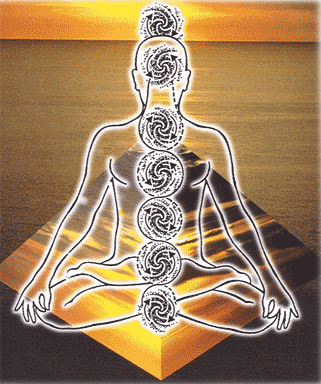
Kundalini Yoga is a meditative discipline - or a system of meditative techniques and movements - within the yogic tradition that focuses on psycho-spiritual growth and the body's potential for maturation. The practice of Kundalini Yoga consists of a number bodily postures, expressive movements and utterances, characterological cultivations, breathing patterns, and degrees of concentration.
The movements and the body-work should not - according to some scholars of religion - be considered mere stretching exercises. The concept of life-energy - pranotthana - is central to the practice and understanding of Kundalini Yoga. It also gives special consideration to the role of the spine and the endocrine system in the understanding of yogic awakening. Recently, there has been a growing interest within the medical community to study the physiological effects of meditation, and some of these studies have applied the discipline of Kundalini Yoga to their clinical settings.
Kundalini is mainly associated with Hinduism. However, Kundalini as a spiritual experience is thought to have parallels in many of the mystical and gnostic traditions of the world's great religions.
Many factors point to the universality of the phenomenon. The early Christians might have referred to the concept as 'pneuma', and there are some recent parallels in contemporary Christian Charismatic 'Holy Ghost' phenomena. Religious studies also note parallels in Quakerism, Shakerism, Judaic Shuckling (torso-rocking prayer), the swaying zikr and whirling dervish of Islam, the quiverings of the Eastern Orthodox hesychast, the flowing movements of tai chi, the ecstatic shamanic dance, the ntum trance dance of the Bushman, Tibetan Buddhist tummo heat as practised by Milarepa, and the Indically-derived Andalusian flamenco (Sovatsky, 1998). Kundalini practice is centerfold in Japan's Aum Shinrikyo group and Kundalini-yoga is also one of the stages the practitioner is able to achieve.
According to yogic terminology the force of Kundalini is supposed to be raised through meditative exercises and activated within the concept of a subtle body, a body of energy and finer substance. This process has been explained in detail by Motoyama (1981) and by Sharp (2005). Motoyama bases the bulk of the Kundalini raising practices listed in the book on the notable Swami Satyananda Saraswati, as well as on personal experience in helping people in various stages of Kundalini awakening. Sharp provides a kundalini meditation called The Great Invocation along with detailed guidance on controlling and managing the energy flow and subsequent manifestation.
Kundalini experiences are often understood in terms of the Hindu chakra system, the understanding of psycho-spiritual energy centers along the spine (Scotton, 1996). According to Hindu tradition the Kundalini raises from the root-chakra up through the spinal channel, called sushumna, and it is believed to activate each chakra it goes through.
Each chakra is said to contain special characteristics (Scotton, 1996). In raising Kundalini, spiritual powers (siddhis) are also believed to arise, but many spiritual traditions see these phenomena as obstacles on the path, and encourages their students not to get hung up with them (Kason, 2000). Although the opening of higher chakras are believed to mark advanced spiritual unfoldment, it is important not to measure spiritual growth solely by the opening of higher potentials. According to this view chakras might be under- or overdeveloped, and lower chakras are thought to be just as important as higher.
Spiritual literature also describes instances where Kundalini is said to be initiated. Initiation of kundalini activity is usually considered to take place by a practice called shaktipat. This is a form of 'laying on of hands' where physical contact to the body or the forehead of the subject by the guru, or initiator, is supposed to cause an experience of Kundalini that later may persist or grow with continuing practice, or fade away if practice is stopped. Scotton (1996) mentions that kundalini-symptomatology is associated with such practices as shaktipat. He also gives a case-example of such a practice from an American meditation retreat.
According to much contemporary spiritual literature, and the field of Transpersonal Psychology, it is not considered wise to engage in any of these practices without the guidance of a credible teacher or without thorough psychological preparation and education in yoga. Any form of intense contemplative or spiritual practice without the support of a cultural context, or without the support of thorough psychological preparation, is usually considered to be unfortunate, and in some cases even dangerous. Traditional teachers of kundalini meditation also warn neophytes of the potential dangers of experimenting with kundalini Yoga techniques. These warnings should not be underestimated. A growing body of clinical and psychological literature notes the growing occurrence of meditation-related problems in Western contemplative life. Among these we find the Kundalini Syndrome (which is presented more closely later in this article) and different forms of "wind illness" described in the Tibetan tradition.
Theorists within the schools of Humanistic psychology, Transpersonal psychology and Near-Death Studies describe a complex pattern of motor functions, sensory, affective and cognitive-hermeneutic symptoms called the Kundalini Syndrome. This psychosomatic arousal and excitation is believed to occur in connection with prolonged and intensive spiritual or contemplative practice (such as meditation or yoga) or as a result of intense life experience or a near encounter with death (such as a near-death experience).
According to these fields of study the Kundalini syndrome is of a different nature than a single Kundalini episode, such as a Kundalini arousal. The Kundalini syndrome is a process that might unfold over several months, or even years. If the accompanying symptoms unfold in an intense manner - that de-stabilizes the person - the process is usually interpreted as what Stanislav Grof has termed "spiritual emergency"
Interdisciplinary dialogues within the mentioned schools of psychology (see references below) have now established some common criteria in order to describe this condition, of which the most prominent feature is a feeling of energy travelling along the spine, or progressing upwards in the body. Motor symptoms are said to include tremors, other spontaneous or involuntary body movements and changes in respiratory function.
Sensory symptoms are said to include subjective changes in body temperature - feelings of heat or cold - a feeling of electricity in the body, persistent sexual arousal syndrome, headache and pressure inside of the head, tingling, vibrations and gastro-intestinal problems. Cognitive and affective symptoms are said to include psychological upheaval, stress, depression, depersonalization or derealization, intense mood-swings, but also moments of bliss, deep peace and other altered states of consciousness. Within the mentioned academic traditions this symptomatology is often referred to as the Physio-Kundalini syndrome or Kundalini-experience Awakening.
Transpersonal literature emphasizes that this list of symptoms is not meant to be used as a tool for self-diagnosis. Any unusual or marked physical or mental symptom needs to be investigated by a qualified medical doctor.
Contemporary spiritual literature often notes that the chakras, as described in the esoteric kundalini documents, bear a strong similarity in location and number to the major endocrine glands, as well as nerve bundles called ganglions.
One speculation is that the traditional practices have formalized a method for stimulating the endocrine glands to work in a different mode which has a more direct effect on consciousness, perhaps ultimately by stimulating the release of DMT by the pineal gland, which may be analogous to the 'pineal chakra'.
The late Itzhak Bentov studied Kundalini from an engineering perspective. According to Bentov (1990), the 7.5 Hz oscillation of the heart muscle rhythm induces mechanical Hz frequencies in the brain, that in turn create a stimulus equivalent of a current loop. The nerve endings in that loop correspond to the route through which the Kundalini "rises".
This current polarizes the brain part through which it flows in a homogenous way, effectively releasing tremendous amounts of stress from the body. The body then becomes an effective antenna for the 7.5 Hz frequency, which is one of the resonant frequencies of the ionosphere. In layman's terms, you then pick up information from the air.
This might account for repeated descriptions of heightened senses as a result of rising Kundalini, e.g. as described by Yogananda: "The whole vicinity lay bare before me. My ordinary frontal vision was now changed to a vast spherical sight, simultaneously all-perceptive."
When practiced in a religious context, Kundalini is mostly beneficial and benevolent. However, examples exist of historical figures suffering from kundalini symptoms, such as zen master Hakuin, Saint Theresa, and Nietzsche. The physiological precursors of kundalini also have the potential to diverge into some peculiar types of pathology, as when induced via violence and outside a religious context, where it may be part of a post-traumatic response. Post-traumatic stress disorder researcher Dr. Jonathan Shay (1994) describes several cases with kundalini-like symptoms in his book Achilles in Vietnam.
According to transpersonal theorists the phenomenon of kundalini is not necessarily pathological in itself, but it might produce serious physiological and psychodynamic symptoms if it is activated outside a proper socio-cultural context, or if it conflicts with already existing and underlying psychopathology or issues connected to overall human development.
Kundalini Wikipedia
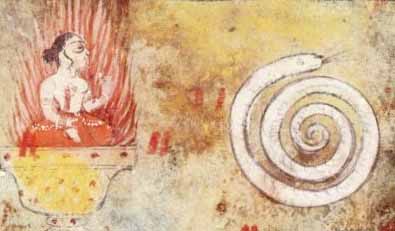
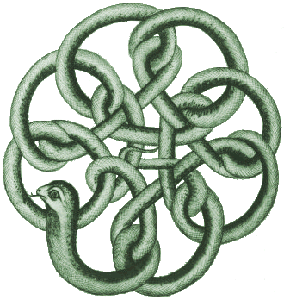
The coiled and dormant 'feminine' energy, refers to the vast potential of psychic energy contained within us all. It is normally symbolized as a serpent coiled into three and a half circles, with its tail in its mouth, and spiraling around the central axis (sacrum or sacred bone) at the base of the spine. The awakening of this serpent and the manifestation of its powers is a primary aim of the practice of Kundalini Yoga. The image of coiling, like a spring, conveys the sense of untapped potential energy that will spring into action soon. For now we remember in small doses.
Kundalini can be described as a great reservoir of creative energy at the base of the spine. It's not useful to sit with our consciousness fixed in our head and think of kundalini as a foreign force running up and down our spine. The concept of kundalini can also be examined from a strictly psychological perspective. From this perspective kundalini can be thought of as a rich source of psychic or libidinous energy in our unconscious.
- Activating Your DNA
- Opening your Clairvoyant and Clairaudient abilities.
- Feeling connected to the oneness of the universe
- Your mind feels expanded in its quest for higher awareness and knowledge
- Allowing your ego to step aside and connecting with higher frequency of thought and consciousness
- Feeling unconditional love, peace, and connection with spirit
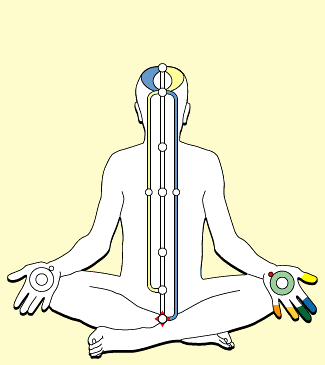
Kundalini is most often awaken through Yoga meditation - which include Mantra Yoga, Hatha Yoga, Laya Yoga or Kriya Yoga. I have prepared a meditation to help you on your path should Yoga not be available to you.
To prepare for this meditation - you might want to tape record the words on this page to listen to as your move through the meditation. Please speak slowly and softly.
Allow lots of time for the meditation - as you will need to relax when you are finished.
You may want to listen to music or be in a quiet place - or be in nature.
Adjust the lighting and room temperature.
Adjust clothing . . . footwear . . . eyeglasses.
Sit down or lie down
Find a position that is comfortable for you.
Quiet your mind . . . Still your thoughts.
Relax your body
Your face . . . your jaw . . . relaxing
Your shoulders . . . your neck . . . relaxed
Your arms . . . your hands . . . feel at peace.
Your torso . . . your hips . . . letting go
Your legs . . . your feet . . . totally relaxed
Focus on your breathing.
Inhale slowly and deeply through your nose.
Retain the breath as long as is comfortable.
Exhale through the mouth slowly and completely.
Repeat for two more breaths . . . or as is comfortable.
Now focus your attention on your chakras.
Starting from the top of your head visualize your crown chakra opening.
Watch as pure white light enters your crown chakra
and slowly spirals down through your spine.
The white light opens your third eye chakra.
You may experiences vibrant colors especially in blue, and violet . . .
The white light moves down to your throat chakra releasing your blockages.
You may feel like chanting or singing.
Allow the tones to resonant from your throat.
Do this as long as is comfortable . . .
The white light now enters your heart chakra.
You experience a feeling of unconditional love and compassion.
The white light enters your solar plexus.
Gently your fears - anger - tensions are released.
See the white light enter your spleen chakra
releasing pain and guilt linked to that chakra.
The white light now enters your Root Chakra
the seat of your kundalini energy.
As it does, it begins to activate the energy of the base (root) chakra.
Feel the energy suddenly emerge from your Root Chakra,
Spiraling up through the base of your spine
as if it were a coiled snake.
The coiled snake represents the spiraling DNA -
opening, activating, bringing you to higher levels of consciousness.
Allow the energy to flow through your chakras.
See the energy wheels rotating.
When your are ready - return your consciousness to your physical body.
Relax and balance your energies.
You might want to drink some water.
Uraeus, Egyptian Connections
